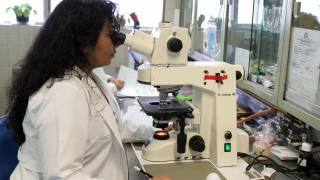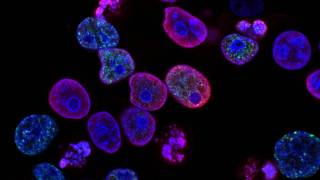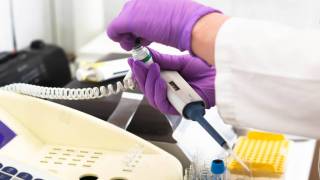Rice University Invented Prostate Cancer Therapy Excels in Clinical Trial

A new prostate cancer therapy invented at Rice University in Texas may have completed a decades-long quest to develop a treatment that destroys tumors without the debilitating side effects of chemotherapy, invasive surgery, and radiation.
Thirteen of the first 15 prostate cancer patients treated in this clinical trial of the nanoparticle-based, focal therapy, showed no detectable signs of cancer a year after treatment, according to a study published on August 26, 2019.
The study authors say this is the first published clinical study of photothermal cancer therapy -- one that uses illuminated nanoparticles to heat and destroy tumors -- in a referenced scientific journal.
The trial, which is ongoing and has treated 44 patients is the culmination of a 20-year quest by Rice University engineer and nanoscientist Naomi J. Halas, Ph.D., and Duke University bioengineer Jennifer West.
Halas and West, co-authors of the new study, first envisioned the nanoparticle-based therapy around 2000 while working together in Rice's Brown School of Engineering.
From the outset, West and Halas had imagined a treatment that would destroy cancer without the debilitating side effects often associated with chemotherapy, invasive surgery, and radiation.
In the study, 16 men ages 58 to 79 with low- to intermediate-risk localized prostate cancer agreed to participate in a trial of AuroLase Therapy, a focal ablation treatment that uses gold nanoparticles to heat and destroy tumors.
Of the 15 initial men who completed treatment, only 2 showed detectable signs of cancer in follow-up biopsies and MRIs one year later.
"Gold-silica nanoshell infusion allows for a focused therapy that treats the cancer while sparing the rest of the prostate, thus preserving a patient's quality of life by reducing unwanted side effects," said study lead author and trial principal investigator Dr. Ardeshir Rastinehad, at the Icahn School of Medicine at Mount Sinai, in a press release.
The particles, tiny silica spheres with a thin outer layer of gold, are called nanoshells.
They are about 50 times smaller than a red blood cell, and Halas invented them at Rice in 1997.
By varying the thickness of the gold shell, Halas had shown she could tune nanoshells to interact with specific wavelengths of light.
Around the year 2000, she and West invented a method of destroying cancer cells by heating nanoshells with a low-power, near-infrared laser that could pass harmlessly through healthy tissue.
The work garnered national awards and press coverage, and by the early 2000s, Halas and West had co-founded a Houston-based startup, Nanospectra Biosciences, to develop the technology for clinical use.
At the time, Nanospectra was still conducting the necessary pre-clinical work to show that nanoshells could be safely used in humans.
"The science hasn't changed," West said. "If you look back to our original PNAS paper, where we did the first animal studies, there's nothing fundamentally different in the science."
But, getting clinical trials approved by the Food and Drug Administration (FDA) was not easy, in part because the technology was groundbreaking.
"We were the first, really engineered nanoparticle to go into human beings," Dr. West said.
"In the beginning, the FDA wasn't sure how to handle these types of materials. We had something that looked like an injectable liquid in an IV bag. Was it a drug or a device? There was a point in time where the FDA was discussing creating a whole new division just for nano."
In the end, the FDA opted to regulate the treatment, which Nanospectra branded as AuroLase Therapy, as a medical device.
In 2011, researchers from the National Institutes of Health published results of a new technique that combined ultrasound and MRI imaging to resolve prostate tumors with millimeter-scale precision, Halas said.
Clinicians began the adoption of the technique for "fusion biopsies," a procedure for targeting needle biopsies to the specific site of suspected tumors.
One of the lead researchers working to develop fusion biopsy technology was Dr. Rastinehad, who joined Mount Sinai in 2015 and was an early proponent of using the fusion imaging platform for "focal therapy," minimally invasive treatment that could target tumors without the risks of incontinence and impotency that were associated with whole-gland treatments like surgical removal of the prostate or radiation.
For Halas and West, the newly published study is another, important step in a 20-year journey that's always been personal and deeply moving.
"This (study) is 16 men, but when does it get to be 16,000? Sixteen million? Because 1 in 9 men are going to have to deal with this in their lifetime. The thought that this treatment could alleviate the side effects, and the misery, that my dad experienced is truly heartwarming."
Dr. West said the results show what is possible when physicians and engineers work together to solve problems.
"This work demonstrates the power of collaboration across engineering and medicine," she said.
"It shows how collaboration can enable the translation of exciting new technologies into clinical medicine to improve the lives of patients."
Additional study co-authors include Harry Anastos, Ethan Wajswol, Jared Winoker, John Sfakianos, Sai Doppalapudi, Michael Carrick, Cynthia Knauer, Bachir Taouli, Sara Lewis and Ashutosh Tewari, all of Mount Sinai; Jon Schwartz of Nanospectra Biosciences; Steven Canfield of the University of Texas Health Science Center at Houston; and Arvin George of the University of Michigan Health System. These researchers disclosed potential conflicts of interest.
Correspondence may be addressed. Email: [email protected] or [email protected].
Nanospectra Biosciences Inc. (Houston, TX) is the primary sponsor of the study providing financial funding for the trial. Invivo, a Philips Healthcare Company (Best, Netherlands), provided research equipment support. N.J.H. would like to acknowledge the Welch Foundation (C-1220) for their support.
Published by Vax Before Cancer
Our Trust Standards: Medical Advisory Committee
























